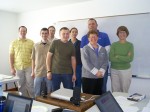SOMA inaugural class settles in at CHCs nationwide
Posted: March 5, 2009
KIRKSVILLE, Mo. – The inaugural class at A.T. Still University’s School of Osteopathic Medicine in Arizona (SOMA), who are scheduled to graduate in 2011, set out in September to community health center campuses (CHCs) across the country that will become their homes for the next three years of their medical education. The School’s ground-breaking contextual learning model places medical students in clinical settings in their second year and, by all accounts, the new model is showing strong signs of success.
“Overall, everything is going quite satisfactorily,” said SOMA Dean Douglas Wood, D.O., Ph.D., regarding the students’ first few months off-campus. He further indicated that feedback from the CHCs, learning facilitators, and students is very positive. Initial feedback also indicates that SOMA students have arrived at the clinics well-prepared for the new clinical setting. “Physicians at the clinical sites are consistently amazed at the amount of knowledge that our students have,” said Dr. Wood. “Because of how our curriculum is set up, we expect nothing less.”
Provost Craig M. Phelps, D.O., FAOASM, ’84, visited sites in Brooklyn, New York, and Beaufort, S.C., to see firsthand how students are progressing. “It is humbling to see how well our students are embraced by the faculty, staff, administration, and most importantly, patients, at their community health center campuses,” said Dr. Phelps. “It is a testament to how well the educational model is working.”
SOMA leadership is not taking their initial success lightly, or for granted. Dr. Wood was quick to point out that SOMA has a strong system in place to monitor progress. Along with phones, email, podcasts, video, and other electronic communication, it is SOMA’s priority to send one of the School’s five deans to each clinical site twice a year to monitor and report progress. Between September and January, eight formal site visits had been completed. The other three sites have received informal visits and are slated for a formal evaluation in the near future. “It is important to have a new set of eyes at each location on a regular basis,” said Dr. Wood.
SOMA student Vanessa DeSousa, OMS II, confirmed that she felt well-prepared when she first started in her clinic in Porterville, Calif. “All of the [first year] OSCEs and medical skills practice, as well as OPP lab, have really helped me to interact with patients appropriately,” she said.
For students at the CHCs, roughly 60 to 70 percent of their time is still spent in didactic education. Each of the 11 campuses has a learning facilitator and a classroom for ongoing instruction. The remaining 30 to 40 percent of their time is spent in the clinic setting, seeing patients who often present the very health issues and illnesses that they are learning about in class.
“When I can put a patient face to the name of a disorder, disease, syndrome, etc…, it stays with me,” said DeSousa. “In addition, having a seasoned physician to talk to about each patient really helps me learn the important clinical and basic science concepts.
“I have had several experiences already where a patient presents with exactly what we are talking about in our basic sciences,” she continued. “It makes sense to learn in the context in which we will be practicing. Physicians have commented that we know a lot already, and that we are very lucky to have early clinical exposure.”